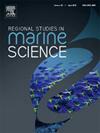不同的细菌和真核生物群落反映了中国南海不同珊瑚礁的特异性
IF 2.1
4区 环境科学与生态学
Q3 ECOLOGY
引用次数: 0
摘要
周围水域的微生物组成对珊瑚礁的健康至关重要,对了解珊瑚礁生态系统的复杂性和环境适应性具有重要价值。本研究揭示了南海不同珊瑚礁区域细菌和真核生物群落的空间异质性和多样性特征。巢指数和香农指数显示不同珊瑚礁细菌和真核生物群落的多样性存在显著差异(p < 0.05)。PCoA(主坐标分析)表明不同地区的群落组成存在显著差异,突出了珊瑚礁环境异质性对微生物群落的关键作用。NST(归一化随机比)分析表明,珊瑚礁地区的群落组合受生态随机过程的影响较大。主要细菌类群包括蛋白质细菌、蓝藻细菌和类细菌,而主要真核生物类群包括叶绿藻纲、吸虫纲、芽孢杆菌纲、花叶藻纲、海藻纲、鞘翅目、褶皱纲-VII 和子囊菌目,每个类群在不同珊瑚礁区域的丰度差异显著(p <0.05)。在所有珊瑚礁水域都检测到了高丰度的 Rhodobacterales 和 Flavobacteriales。相关分析表明,温度、pH 值和盐度是影响细菌和真核生物群落的重要因素。本研究揭示了南海珊瑚礁区域微生物群落的空间异质性,强调了海洋环境异质性对群落结构的重要影响。本文章由计算机程序翻译,如有差异,请以英文原文为准。
Distinct bacterial and eukaryotic communities reflect the specificity of different coral reefs in the South China Sea
The microbial composition of surrounding waters is crucial for the health of coral reefs and holds significant value for understanding the complexity and environmental adaptability of coral reef ecosystems. This study reveals the spatial heterogeneity and diversity characteristics of bacterial and eukaryotic communities in different coral reef regions of the South China Sea. Chao and Shannon indices showed significant differences (p < 0.05) in diversity of bacterial and eukaryotic communities across different coral reefs. PCoA (principal coordinate analysis) indicates significant differences in community composition among regions, highlighting the crucial role of coral reef environmental heterogeneity on microbial community. NST (normalized stochasticity ratio) analysis indicates that community assembly in coral reef areas is more influenced by ecological stochastic processes. Major bacterial groups include Proteobacteria, Cyanobacteria, and Bacteroidota, while dominant eukaryotic groups include Dinophyceae, Apicomplexa, Bacillariophyta, Florideophyceae, Mamiellophyceae, Syndiniales, Prasino-Clade-VII, and Ascomycota, each showing significant abundance differences across coral reef regions (p < 0.05). High abundance of Rhodobacterales and Flavobacteriales are detected in all coral reef waters. Correlation analysis indicates that temperature, pH, and salinity are important factors affecting the bacterial and eukaryotic communities. This study reveals the spatial heterogeneity of microbial communities in coral reef regions of South China Sea and underscores the significant impact of marine environmental heterogeneity on community structure.
求助全文
通过发布文献求助,成功后即可免费获取论文全文。
去求助
来源期刊

Regional Studies in Marine Science
Agricultural and Biological Sciences-Ecology, Evolution, Behavior and Systematics
CiteScore
3.90
自引率
4.80%
发文量
336
审稿时长
69 days
期刊介绍:
REGIONAL STUDIES IN MARINE SCIENCE will publish scientifically sound papers on regional aspects of maritime and marine resources in estuaries, coastal zones, continental shelf, the seas and oceans.
 求助内容:
求助内容: 应助结果提醒方式:
应助结果提醒方式:


